Yaesu FT-70DE, FT-70DR User Manual
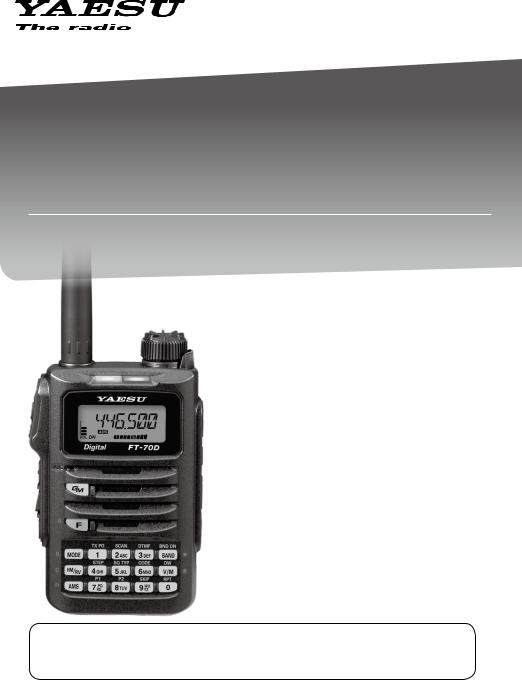
C4FM/FM 144/430MHz
DIGITAL/ANALOG TRANSCEIVER
FT-70DR FT-70DE
Advance Manual
Clicking (tapping) at the  at the bottom left of the current browsing page, will return to the contents page at any time.
at the bottom left of the current browsing page, will return to the contents page at any time.

Contents |
|
Digital Personal ID (DP-ID) feature..................................... |
4 |
About the Digital Personal ID (DP-ID) feature.................... |
4 |
Registering the DP-ID of the other station...................... |
4 |
Communicating with specified other station in the |
|
Analog FM mode.................................................................. |
7 |
Selecting the Squelch Type in the Analog FM Mode.......... |
7 |
Tone squelch feature.......................................................... |
8 |
Setting CTCSS Tone frequency...................................... |
8 |
Searching for the CTCSS Tone transmitted |
|
by the other Station.... |
8 |
Digital Code Squelch (DCS) feature................................... |
9 |
Setting the DCS CODE.................................................. |
9 |
Searching for the DCS Code Used |
|
by the Other Station..... |
9 |
New Two CTCSS Tone Pager Function............................ |
10 |
Using the Pager Function............................................. |
10 |
Setting the Code for Your Station................................. |
10 |
Calling a Specific Station.............................................. |
11 |
Receiving “pager code” calls from a |
|
Remote Station (Standby Operation)..... |
11 |
Using the Pager Answer Back...................................... |
11 |
Notification of a Call from a Remote Station |
|
by the Bell Function..... |
12 |
User Programmed Reverse CTCSS Decoder.................. |
12 |
Convenient Functions....................................................... |
13 |
Split Memory.................................................................... |
13 |
Using Memory Tag........................................................... |
13 |
Changing between name tag display |
|
and frequency display..... |
14 |
The Memory Channel Only Mode.................................... |
14 |
Using Memory Banks....................................................... |
15 |
Registering to Memory Banks...................................... |
15 |
Open the Memory Bank display................................... |
15 |
Open Memory Bank Channels..................................... |
16 |
Canceling a Memory Channel Registered |
|
in Memory a Bank.... |
16 |
Assigning a Name to a Memory Bank.......................... |
16 |
Skipping Unwanted Scan Frequencies |
|
(Skip Search Memory)..... |
17 |
Setting Skip Memory Channel |
|
and Specified Memory Channel.... |
17 |
Scanning Only the Specified Memory Channels.......... |
18 |
Programmable Memory Channel Scan (PMS)................. |
18 |
Registering to the Programmable Memory Channels... |
18 |
Performing Programmable Memory Channel Scan...... |
18 |
Dual Receive (DW) Function............................................ |
19 |
Registering the priority channel.................................... |
19 |
Activating the Dual Receive (DW) feature.................... |
20 |
Setting the Dual Receive (DW) Resume Conditions .... |
20 |
DTMF Operation............................................................... |
21 |
Setting the DTMF Memory........................................... |
21 |
Transmitting the Registered DTMF Code..................... |
22 |
Manually Transmitting the DTMF Code....................... |
22 |
Customizing Menu Settings |
|
and User Preferences (Set Mode)..... |
23 |
Setting the Set Mode........................................................ |
23 |
Reset All........................................................................... |
24 |
Set Mode Reset................................................................ |
24 |
Tables of Set Mode Operations........................................ |
25 |
Functions to Use as Necessary........................................ |
43 |
Using the Transceiver for Packet Communication............ |
43 |
Clone Operation............................................................... |
44 |
Connecting to a PC.......................................................... |
45 |
Updating the firmware.................................................. |
45 |
If you suspect malfunction................................................ |
46 |
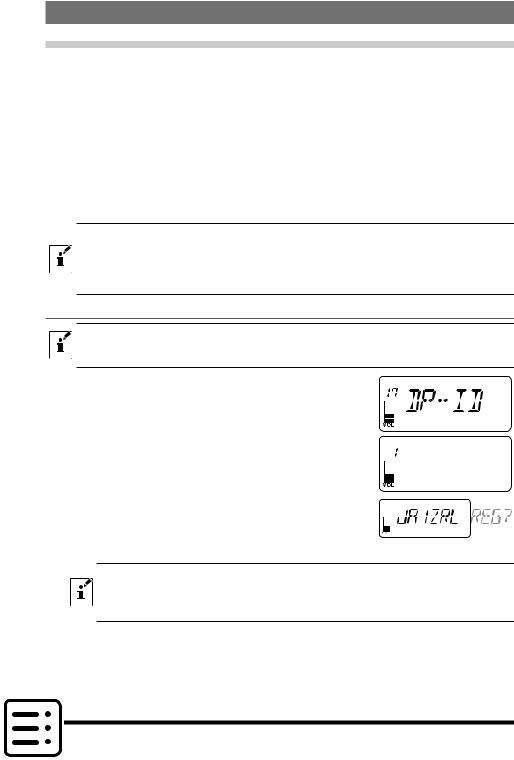
Digital Personal ID (DP-ID) feature
About the Digital Personal ID (DP-ID) feature
When operating in digital C4FM communications, each transceiver is programmed with, and sends its own individual ID information (Radio ID) in each transmission. The DP-ID function and the individual identification information, makes possible group communications of stations that are within communications range.
Digital Personal ID (DP-ID) feature opens the speaker audio only when a signal set to the same DP-ID in the Digital Mode is received, even if each transceiver is set a different Digital Group ID (DG-ID) number.
The digital C4FM repeater equipped with the DP-ID function allows preferentially contact in an emergency, regardless of the repeater setting or if the repeater is being used without the DG-ID setting.
zzDigital C4FM mode transceivers compatible with the DG-ID function are required in order to utilize this function.
zzIf the firmware is not compatible with the DG-ID function, update to the latest firmware to use the DG-ID function. The latest firmware is available on the YAESU website. The latest firmware is available on the YAESU website. The latest firmware is available on the YAESU website.
Registering the DP-ID of the other station
When setting the DG-ID code to “00”, the transceiver will receive signals from all digital C4FM stations. To utilize the DP-ID function, it is necessary to set the receive DG-ID code to a number other than “00”.
1. Press and hold the [F] key, to enter the Set Mode. 2. Rotate the DIAL knob to select [17 DP-ID].
3. Press the [F] key.
• The DP-ID list is displayed.
• If a number of DP-IDs are registered, rotate the DIAL knob to display the desired DP-ID.
4. A transmission in the digital C4FM mode from the other transceiver will register the DP-ID.
When a signal from the other station is received, the callsign and “REG” are displayed on the LCD.
zz When a signal from another registered transceiver is received, nothing is display on the LCD.
zzWhen registering a transceiver already registered with a different call sign, the call sign registered in the DP-ID list is changed to the new registered call sign.
4 FT-70DR/DE Advance Manual
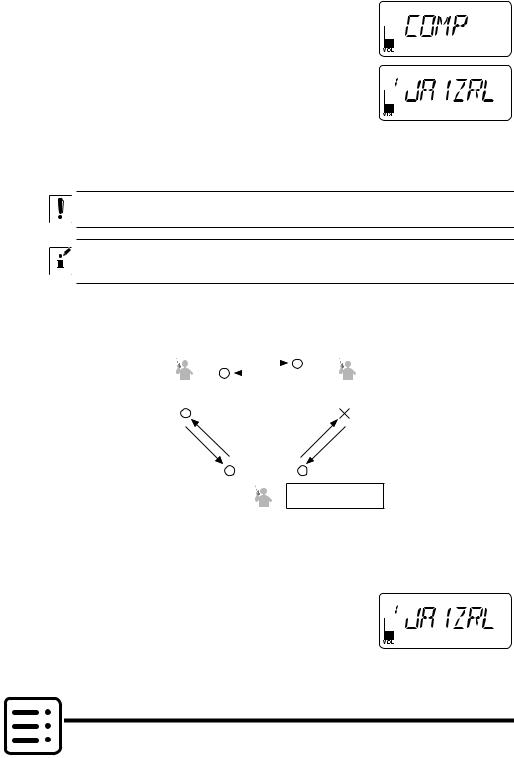
5. Press and hold the [GM] key.
• When registering in the DP-ID list is finished, “COMP” is displayed for three seconds, then the display returns to the DP-ID list screen.
• If not registering the DP-ID, press the [GM] key.
• If registering several DP-IDs, repeat step 4 and 5.
• A maximum of 24 stations may be registered.
6.Press the PTT switch to save the setting and return to normal operation.
•Similarly, register all of the communicating transceivers’ DP-IDs to the DP-ID lists of the other stations.
•The DP-ID setting is complete.
When using the DP-ID function in the Voice FR mode(Voice Full Rate Mode)communication mode, turn the battery saver function OFF in the Set Mode [48 RX SAVE] (see  39).
39).
For communicating using the DP-ID function, register the DP-ID of each other’s transceiver on both transceivers. By registering the DP-ID, users may communicate even if the Digital group ID (DG-ID) is a different setting.
|
|
Each transceivers may communicate |
|
|
||||
|
|
even if the Digital Group ID (DG-ID) is |
|
|
||||
|
|
a different setting because A Station |
|
|
||||
|
|
and B station register the DP-ID of |
|
|
||||
|
|
each other’ s transceiver on both |
|
|
||||
|
A |
trasnceivers. |
B |
|
||||
|
|
|
|
|
|
|
||
DP-ID list |
|
|
|
|
|
|
|
DP-ID list |
B station's DP-ID “bbbbb” |
|
|
|
|
|
|
|
A station's DP-ID “aaaaa” |
|
|
|
|
|
|
|
|
|
DP-ID: aaaaa
DG-ID: TX01 RX01
A station and C station do not register the DP-ID of each other’ s transceiver o n b o t h t r a n s c e i v e r s , b u t e a c h transceivers may communicate because the same DG-ID is set to both transceivers.
DP-ID: bbbbb
DG-ID: TX02 RX02
B S t a t i o n m a y n o t r e c e i v e t h e C station's signal because B station does not register the C station's DP-ID.
C station may receive the B station's signal because C station register the B
station's DP-ID.
C
DP-ID list
B station's DP-ID “bbbbb”
DP-ID: ccccc
DG-ID: TX01 RX01
●● Deleting the registered DP-ID
1.Press and hold the [F] key to enter the Set Mode.
2.Rotate the DIAL knob to select [17 DP-ID].
3.Press the [F] key.
The DP-ID list is displayed.
5 FT-70DR/DE Advance Manual
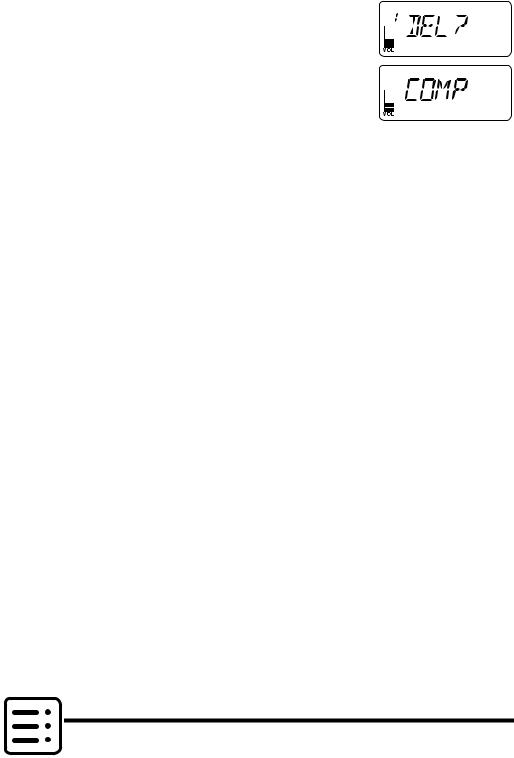
4. Rotate the DIAL knob to select the call sign of the other transceiver, then press and hold the [GM] key.
The call sign of the transmitted transceiver and “DEL?” is displayed.
5. Press and hold the [GM] key.
• When finishing registering in the DP-ID list, the “COMP” is displayed for three seconds.
• If not registering another DP-ID, press the [GM] key.
• If registering several DP-IDs, repeat step 4 and 5.
6.Press the PTT switch to save the new setting and return to normal operation.
6 FT-70DR/DE Advance Manual
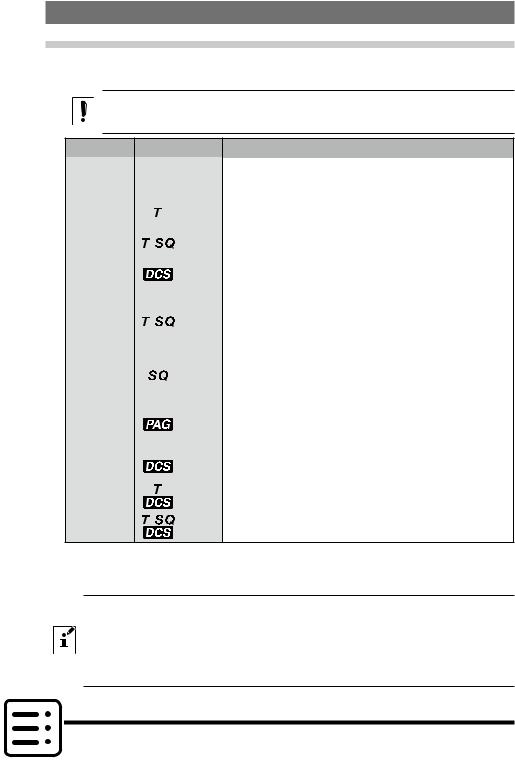
Communicating with specified other station in the Analog FM mode
Selecting the Squelch Type in the Analog FM Mode
1.Press the [F] key, then press the [5] (SQ TYP) key.
2.Rotate the DIAL knob to adjust to a level at which the background noise is muted.
Tone squelch (CTCSS), DCS and the New PAGER (EPCS) functions do not operate in the
C4FM digital mode. Press the [MODE] key to change to the Analog FM mode, or press and hold the [AMS] key to turn the AMS function ON (AMS icon appears).
Squelch type |
Icon indication |
Description |
|||
|
|
|
|
|
Deactivates the tone squelch function and DCS function |
OFF |
|
|
|
- |
OFF, then returns to the normal squelch operation in the An- |
|
|
|
|
|
alog FM mode. |
TONE |
|
|
|
appears |
Analog FM Transmissions contain the CTCSS tone. |
|
|
|
Receives as a normal squelch operation. |
||
TSQL |
|
|
|
appears |
Activates the CTCSS tone squelch function on Analog FM |
|
|
|
|
|
receive. |
DCS |
|
|
|
appears |
Activates the Digital Code Squelch (DCS) function. |
|
|
|
|
|
The DCS code may be selected from 104 codes (from 023 to 754). |
|
|
|
|
|
Activates the reverse tone function. |
|
|
|
|
|
Used to monitor communications based on the squelch con- |
RV TN |
|
|
|
(Blinks) |
trol system. When a signal contains the designated tone, the |
|
|
|
|
|
squelch is not opened, and when the tone signal disappears, |
|
|
|
|
|
the squelch opens and communication starts. |
|
|
|
|
|
Activates the no-communication squelch function for radios. |
PR FRQ |
|
(appears) |
The no-communication signal tone frequencies may be speci- |
||
|
|
|
|
|
fied within the range from 300 Hz to 3000 Hz in steps of 100 Hz. |
|
|
|
|
|
Activates a new two-tone CTCSS pager function. |
PAGER |
|
|
(appears) |
When communicating with FT-70DR/DE transceivers among |
|
|
|
friends, specify personal codes (each code is composed of |
|||
|
|
|
|
|
two tones) so that you can call only specific stations. |
D CODE |
* |
(Blinks) |
Transmits the signal containing the DCS CODE. |
||
|
Receives as a normal squelch operation. |
||||
T DCS |
* |
|
|
(Blinks) |
Sends a tone signal when transmitting, and receives the |
|
|
|
(appears) |
only signal matches the DCS code when receiving. |
|
|
|
|
|
||
D TONE |
* |
(appears) |
Sends the DCS CODE when transmitting, and receives only |
||
|
|
(Blinks) |
signals that contain a matching tone signal when receiving. |
||
|
|
|
|
||
*:Turning the Set Mode [54 SQL.EXP] SPL ON ( 40), “D CODE”, “T DCS” and “D TONE” setting values are activated.
40), “D CODE”, “T DCS” and “D TONE” setting values are activated.
3. Press the PTT switch to save the setting and return to normal operation.
zzThe squelch type may be set for each frequency band (BAND).
zzThe CTCSS and DCS squelch settings are also active during scanning. If scanning is performed with the CTCSS and DCS squelch function activated, scanning stops only when a signal containing the specified CTCSS tone or DCS code is received.
zzPressing the MONI/T-CALL switch allows signals that do not contain a tone or DCS code, and signals with different tones, DCS codes, digital mode signals to all be heard.
zzSet Mode [13 DCS.INV] ( 30) allows to receive the DCS code of the inverted phase.
30) allows to receive the DCS code of the inverted phase.
7 FT-70DR/DE Advance Manual
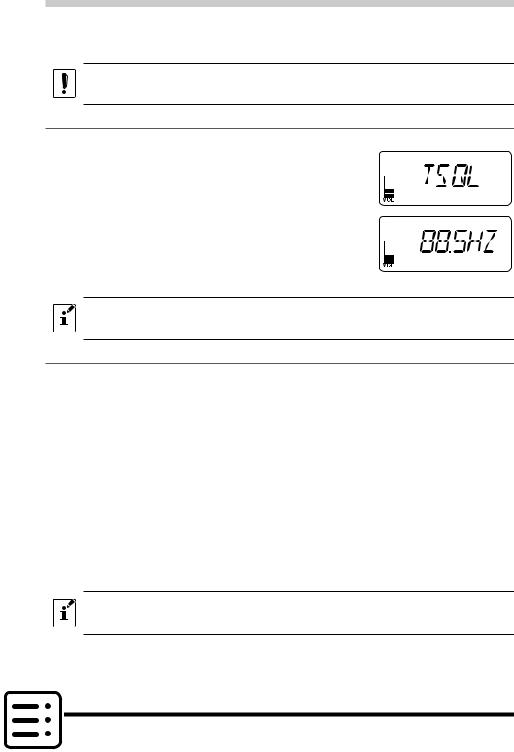
Tone squelch feature
The tone squelch opens the speaker audio only when a signal containing the specified CTCSS tone is received. The receiver will be quiet while waiting for a call from a specific station.
The tone squelch function does not function in digital mode. Press the [MODE] to change the communication mode to Analog FM mode or press and hold the [AMS] key to turn the AMS function ON (the AMS icon appears).
Setting CTCSS Tone frequency
The tone frequency may be selected from 50 frequencies (from 67.0 Hz to 254.1 Hz). 1. Press the [F] key, then press the [5](SQ TYP) key. 

2. Rotate the DIAL knob to select the “TSQL”. 3. Press the PTT switch to save the setting and return to
normal operation. 4. Press the [F] key, then press the [6](CODE) key.
The setting screen of the tone frequency is displayed. 5. Rotate the DIAL knob to select the tone frequency. 6. Press the PTT switch to save the setting and return to
normal operation.
zzThe tone frequency setting is common with the squelch types as follows: TONE, TSQL, RV TN, T DCS, D TONE
zzThe default setting is “88.5 Hz”
Searching for the CTCSS Tone transmitted by the other Station
Search and display the tone squelch CTCSS tone transmitted by the other station.
1.Press the [F] key, then press the [5](SQ TYP) key.
2.Rotate the DIAL knob to select the “TSQL”.
3.Press the PTT switch to save the setting and return to normal operation.
4.Press the [F] key, then press the [6](CODE) key.
The setting screen of the tone frequency is displayed.
5.Press the [BAND] key.
The transceiver begins searching for a matching tone frequency.
When a corresponding tone frequency is detected, a beep sound is emitted, and the detected tone frequency blinks.
The searching stops for 5 seconds and the audio is heard.
6.Press the [BAND] key to stop searching.
7.Press and hold the [F] key.
The detected tone frequency is set.
To set the transceiver operation when scanning stops, set the Set Mode [52 SCN.RSM](
40). This setting is common with the scan setting, tone search function and DCS search function.
8 FT-70DR/DE Advance Manual
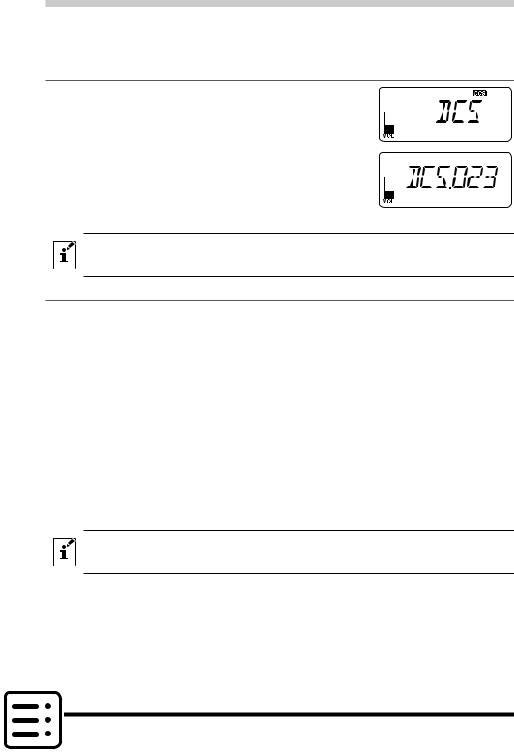
Digital Code Squelch (DCS) feature
The Digital Code Squelch opens the speaker audio only when a signal containing the specified DCS code is received.
The DCS code may be selected from 104 types (from 023 to 754).
Setting the DCS CODE
1. Press the [F] key, then press the [5](SQ TYP) key. 2. Rotate the DIAL knob to select “DCS”.
3. Press the PTT switch to save the setting and return to normal operation.
4. Press the [F] key, then press the [6](CODE) key. The DCS code setting screen is displayed.
5. Rotate the DIAL knob to select the DCS code.
6. Press the PTT switch to save the setting and return to normal operation.
zzThe DCS code set by the above operation is common setting for all transmissions with a
DCS Code (DCS, D CODE, T DCS, D TONE). zzThe default DCS code is “023”.
Searching for the DCS Code Used by the Other Station
Search for the DCS code used by the other station.
1.Press the [F] key, then press the [5](SQ TYP) key.
2.Rotate the DIAL knob to select the “DCS”.
3.Press the PTT switch to save the setting and return to normal operation.
4.Press the [F] key, then press the [6](CODE) key. The DCS code is displayed.
5.Press the [BAND] key.
The transceiver starts to search for the DCS code.
When a corresponding DCS code is detected, a beep sound is emitted. The detected DCS code blinks.
The searching stops for 5 seconds and the audio is heard.
6.Press the [BAND] key to stop searching.
7.Press and hold the [F] key.
The searched DCS code is set and the transceiver exits from Set mode.
To set the transceiver operation when scanning stops, set the Set Mode [52 SCN.RSM](
40). This setting is common with the scan settings, the tone search function and DCS search function.
9 FT-70DR/DE Advance Manual
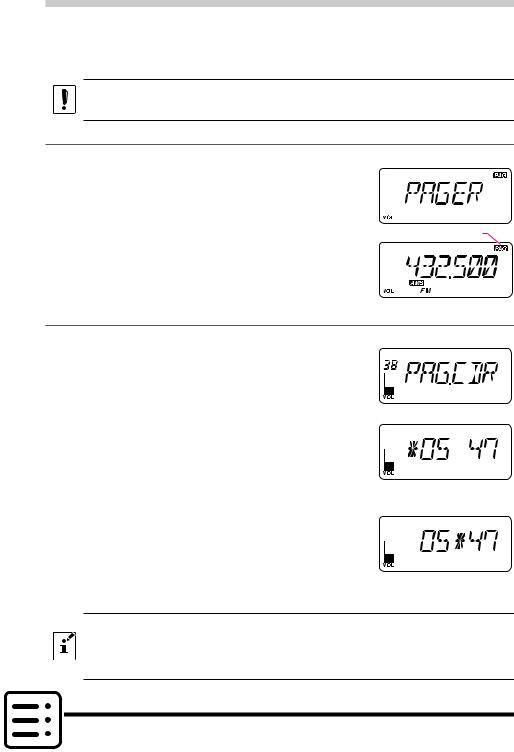
New Two CTCSS Tone Pager Function
When using the FT-70DR/DE transceivers with a group of friends, setting the two CTCSS tone personal codes allows calling just the specific stations. Even when the person who is called is not near the transceiver, the information on the LCD indicates that a call was received.
The new two CTCSS tone pager feature does not operate in the digital mode. Press the [MODE] key to change to the Analog FM mode or press and hold the [AMS] key to turn the AMS function ON.
Using the Pager Function
1. Press the [F] key, then press the [5](SQ TYP) key. 2. Rotate the DIAL knob to select the “PAGER”.
|
|
|
|
|
|
|
|
3. Press the PTT switch to save the setting and return to |
|
New Pager icon |
|
normal operation. |
|
|
|
The new pager function is activated. |
|
|
|
|
|
|
|
|
|
|
|
|
|
|
|
Setting the Code for Your Station
Set the “pager code” to be called by other stations.
1. Press and hold the [F] key, then rotate the DIAL knob to select the Set Mode [38 PAG.CDR].
2.Press the [F] key.
3.Rotate the DIAL knob to select the first element of the
code from 01 to 50.
4.Press the [BAND] key to move the icon to the second element of the code.
5.Rotate the DIAL knob to select the second element of
the code from the 01 to 50.
The first and second element of the code may not be set to the same code.
6.Press the PTT switch to save the setting and return to normal operation.
zzThe reverse combination works as the same code, that is "05 47" is the same as "47 05".
zzIf the same code is specified for all individuals, all the individuals can be called at the same time.
zzThe default code is “05 47”.
zzWhen receiving the signals, the intermittent sound of the tone signal may be heard slightly.
10 FT-70DR/DE Advance Manual

Calling a Specific Station
The “pager code” may be set to call to specific stations.
1.See “Activating the New Pager Function” to initiate the new pager function.
2.Press and hold the [F] key, rotate the DIAL knob to se-
lect the Set Mode [39 PAG.CDT].
3.Press the [F] key.
4.Rotate the DIAL knob to select the first element of the
code from the 01 to 50.
5.Press the [BAND] key to move the icon to the second element of the code.
6.Rotate the DIAL knob to select the second element of
the code from the 01 to 50.
The first and second element may not be set to the same code.
7.Press the PTT switch to save the setting and return to normal operation.
8.Press the PTT switch to transmit a call to the specific station.
Receiving “pager code” calls from a Remote Station (Standby Operation)
When the Pager function is activated, and a call is received with a corresponding Code, the “ ” icon blinks and the audio is heard.
” icon blinks and the audio is heard.
Furthermore, when the Bell function ( 12) is activated, the bell rings and the “
12) is activated, the bell rings and the “ ” icon blinks while calling from the other station.
” icon blinks while calling from the other station.
Using the Pager Answer Back
If the Answer Back feature is ON, when called by another station with a corresponding pager code, the transceiver is automatically placed in the transmit mode (for about 2.5 seconds) to notify the other station that you are ready to communicate.
1. Press and hold the [F] key, rotate the DIAL knob to select the Set Mode [37 PAG.ABK].
2.Press the [F] key.
3.Rotate the DIAL knob to select the “ON”.
4.Press the PTT switch to save the setting and return to normal operation.
11 FT-70DR/DE Advance Manual
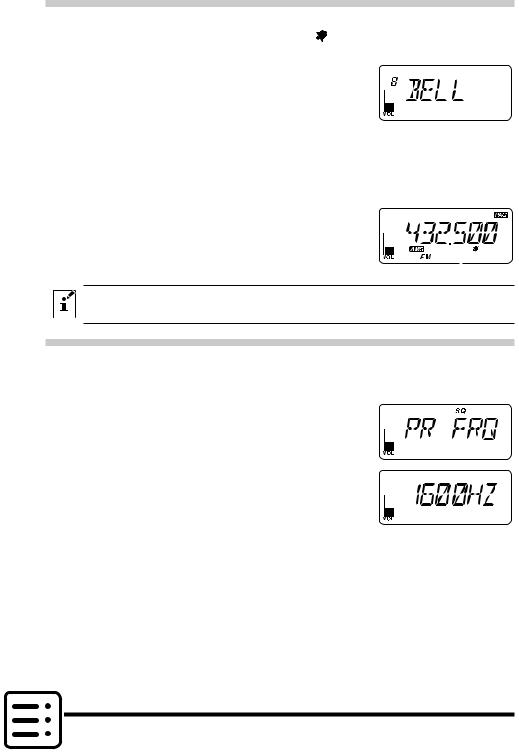
Notification of a Call from a Remote Station by the Bell Function
The Bell may be set to sound an Alert when a call from another station containing a corresponding tone, DCS or pager code is received. ” icon on the LCD blinks to provide a later notice of the call from the other station.
1. Press and hold the [F] key, rotate the DIAL knob to select the Set Mode [8 BELL].
2.Press the [F] key.
3.Rotate the DIAL knob to select the desired number of times (1-20 times or continuous) the Bell rings.
OFF 1T 2T
20T CONT (continuous)
4.Press the PTT switch to save the setting and return to
normal operation.
Bell icon
zzThe default setting is “OFF”.
zzIf setting the “CONT” (continuous), the bell keeps sounding until operating something.
User Programmed Reverse CTCSS Decoder
The tone signal frequency can be set at 100 Hz intervals between 300 Hz and 3000 Hz to mute the audio when receiving a signal containing a CTCSS tone matching the programmed tone.
1. Press the [F] key, then press the [5](SQ TYP) key.
2. Rotate the DIAL knob to select the “PR FRQ”. 3. Press the PTT switch to save the setting and return to
normal operation. 4. Press the [F] key, then press the [6](CODE) key.
The setting screen containing the CTCSS tone frequencies is displayed.
5. Rotate the DIAL knob to select the desired CTCSS tone frequency.
6.Press the PTT switch to save the setting and return to normal operation.
12 FT-70DR/DE Advance Manual
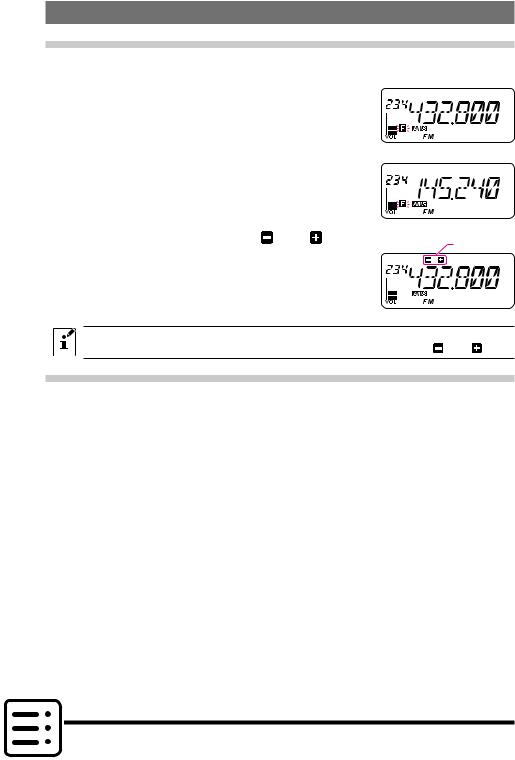
1.Recall the memory channel or home channel to assign the name tag.
2.Press and hold the [F] key, rotate the DIAL knob to select the Set Mode [33 MEM.NAM].
3.Press the [F] key.
The character input screen is displayed.
4.Use the numeric keypad or DIAL knob to input the characters.
•Inputting characters
Example quickly Pressing the [2] key, each time switches the following characters:
A → B → C → 2 → A →
Example Rotating the DIAL switches the following characters.
A - Z (symbol) 0 - 9 (symbol) A - Z
•Moving the cursor, deleting the input character
Moves the cursor to the right Moves the cursor to the left
Pressing and holding the [GM] key: Erases all characters after the cursor
5.Press the PTT switch to save the setting and return to normal operation.
The memory tag is registered to the memory channel, and the Set Mode exits.
13 FT-70DR/DE Advance Manual
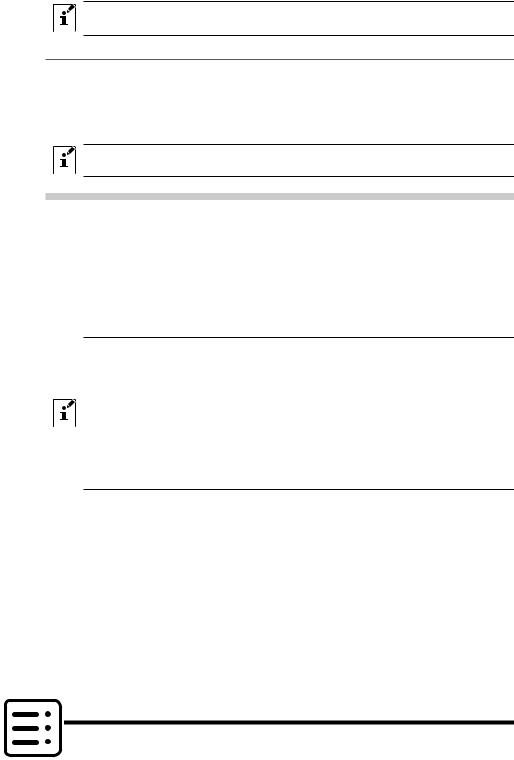
The memory name tag registered to the channel is automatically displayed as the memory tag indication.
Changing between name tag display and frequency display
1.Recall the memory channel or the home channel to be changed.
2.Press the [F] key, then press the [MODE] key.
The display changes between the memory tag display and the frequency display.
•If a name tag has not been set for the memory/home channel, the beep sounds and the display will not change.
If the memory channel or home channel is set to display the memory tag, pressing the [F] key will temporarily display the frequency indication while “ ” is lighted.
” is lighted.
The Memory Channel Only Mode
The FT-70DR/DE may be set to operated only in the registered memory channels.
1.While pressing the [V/M] key, press and hold the POWER (LOCK) switch to turn the transceiver ON.
•The memory channel only mode is ON, the previously selected memory channel is recalled.
•Rotating the DIAL knob may be selected.
•Inputting the 3 digits of the memory channel using the numeric keys may be recalled the memory channel directly.
zz In the memory only mode, only the following functions will operate:
••Changing the communication mode (press the [MODE] key)
••Group monitor (GM) function (press the [GM] key)
••The transmission mode setting of the AMS function (press the [AMS] key)
••Turning the AMS function ON or OFF (press and hold the [AMS] key)
•• Setting of the DG-ID code (press and hold the [MODE] key)
•• Reverse function (press the [F] key, and then press the [HM/RV] key)
••Audio level adjustment (press the VOL key)
••SQL level adjustment (press the [F] key, and then press the MONI/T-CALL switch)
••Key lock function (press the POWER (LOCK) switch
zzPressing the [V/M] key or the [HM/VM] key, will sound the beep, “M-ONLY” will be displayed, and the function will not operate.
zz Canceling Memory Only Mode
1.Turn the transceiver OFF; and then while pressing the [V/M] key, press and hold the POWER (LOCK) switch to turn the transceiver ON.
14 FT-70DR/DE Advance Manual
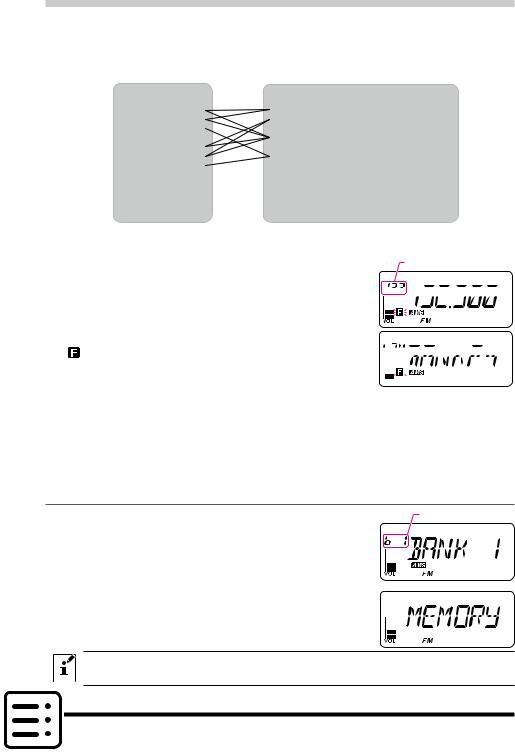
Using Memory Banks
The transceiver allows using up to 24 memory banks to be recalled with the sorted the memory channels. One memory channel may also be registered in two or more memory banks according to the intended use.
Example of registering memory channels to the memory banks:
Memory channels |
|
Memory banks |
|
|
1 |
145.000 MHz |
b1 |
(1 - 100) 144 MHz Amateur Band Channels |
|
2 |
145.500 MHz |
b2 |
(1 - 100) 430 MHz Amateur Band Channels |
|
3 |
120.400 MHz |
b3 |
(1 - 100) |
|
4 |
- |
b4 |
(1 - 100) All Amateur Band Channels |
|
5 |
439.700 MHz |
b5 |
(1 - 100) |
|
6 |
432.800 MHz |
b6 |
(1 - 100) Air Band Channels |
|
7 |
108.700 MHz |
b7 |
(1 - 100) |
|
8 |
- |
b8 |
(1 - 100) |
|
9 |
- |
b9 |
(1 - 100) |
|
10 |
- |
b10 |
(1 - 100) |
|
900 |
~ |
b24 |
~ |
|
- |
(1 - 100) |
|
||
Registering to Memory Banks |
|
|
|
|
1. Press the [V/M] key to enter the memory mode. |
Memory Channel Number |
|||
2.Rotate the DIAL knob to recall the memory channel to
register in the memory bank, 














3.Press and hold the [V/M] key.
”blinks. 






4.Rotate the DIAL to select the memory bank (b1 to b24) 



 to register the memory channel.
to register the memory channel. 

•The memory bank channels are displayed between the memory channel 1 (1CH), and PMS memory channel U50.
5.Press the [V/M] key.
The memory channel is registered in the selected memory bank and the transceiver operation returns to the memory mode.
Open the Memory Bank display
1. Press the [V/M] key to switch to the memory mode. Memory Bank Number
2.Pressing the [BAND] key switches between the normal memory channel display and the memory bank display. BANK££(1 - 24) : The memory bank display
MEMORY : The memory channel display
The display is automatically switched to the selected display after one second.
If no memory channel is registered, setting the following operation sounds the beep and “NO BNK” will be displayed.
15 FT-70DR/DE Advance Manual
